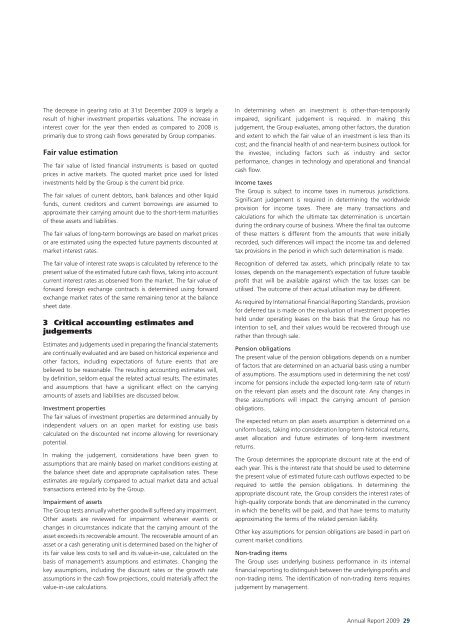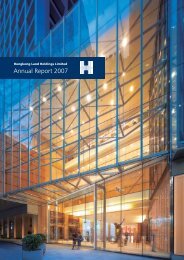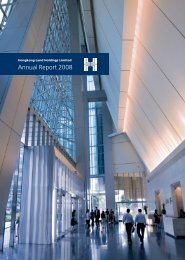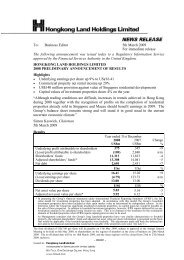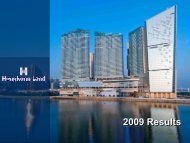Annual Report (in PDF) - Hongkong Land
Annual Report (in PDF) - Hongkong Land
Annual Report (in PDF) - Hongkong Land
Create successful ePaper yourself
Turn your PDF publications into a flip-book with our unique Google optimized e-Paper software.
The decrease <strong>in</strong> gear<strong>in</strong>g ratio at 31st December 2009 is largely a<br />
result of higher <strong>in</strong>vestment properties valuations. The <strong>in</strong>crease <strong>in</strong><br />
<strong>in</strong>terest cover for the year then ended as compared to 2008 is<br />
primarily due to strong cash flows generated by Group companies.<br />
Fair value estimation<br />
The fair value of listed f<strong>in</strong>ancial <strong>in</strong>struments is based on quoted<br />
prices <strong>in</strong> active markets. The quoted market price used for listed<br />
<strong>in</strong>vestments held by the Group is the current bid price.<br />
The fair values of current debtors, bank balances and other liquid<br />
funds, current creditors and current borrow<strong>in</strong>gs are assumed to<br />
approximate their carry<strong>in</strong>g amount due to the short-term maturities<br />
of these assets and liabilities.<br />
The fair values of long-term borrow<strong>in</strong>gs are based on market prices<br />
or are estimated us<strong>in</strong>g the expected future payments discounted at<br />
market <strong>in</strong>terest rates.<br />
The fair value of <strong>in</strong>terest rate swaps is calculated by reference to the<br />
present value of the estimated future cash flows, tak<strong>in</strong>g <strong>in</strong>to account<br />
current <strong>in</strong>terest rates as observed from the market. The fair value of<br />
forward foreign exchange contracts is determ<strong>in</strong>ed us<strong>in</strong>g forward<br />
exchange market rates of the same rema<strong>in</strong><strong>in</strong>g tenor at the balance<br />
sheet date.<br />
3 Critical account<strong>in</strong>g estimates and<br />
judgements<br />
Estimates and judgements used <strong>in</strong> prepar<strong>in</strong>g the f<strong>in</strong>ancial statements<br />
are cont<strong>in</strong>ually evaluated and are based on historical experience and<br />
other factors, <strong>in</strong>clud<strong>in</strong>g expectations of future events that are<br />
believed to be reasonable. The result<strong>in</strong>g account<strong>in</strong>g estimates will,<br />
by def<strong>in</strong>ition, seldom equal the related actual results. The estimates<br />
and assumptions that have a significant effect on the carry<strong>in</strong>g<br />
amounts of assets and liabilities are discussed below.<br />
Investment properties<br />
The fair values of <strong>in</strong>vestment properties are determ<strong>in</strong>ed annually by<br />
<strong>in</strong>dependent valuers on an open market for exist<strong>in</strong>g use basis<br />
calculated on the discounted net <strong>in</strong>come allow<strong>in</strong>g for reversionary<br />
potential.<br />
In mak<strong>in</strong>g the judgement, considerations have been given to<br />
assumptions that are ma<strong>in</strong>ly based on market conditions exist<strong>in</strong>g at<br />
the balance sheet date and appropriate capitalisation rates. These<br />
estimates are regularly compared to actual market data and actual<br />
transactions entered <strong>in</strong>to by the Group.<br />
Impairment of assets<br />
The Group tests annually whether goodwill suffered any impairment.<br />
Other assets are reviewed for impairment whenever events or<br />
changes <strong>in</strong> circumstances <strong>in</strong>dicate that the carry<strong>in</strong>g amount of the<br />
asset exceeds its recoverable amount. The recoverable amount of an<br />
asset or a cash generat<strong>in</strong>g unit is determ<strong>in</strong>ed based on the higher of<br />
its fair value less costs to sell and its value-<strong>in</strong>-use, calculated on the<br />
basis of management’s assumptions and estimates. Chang<strong>in</strong>g the<br />
key assumptions, <strong>in</strong>clud<strong>in</strong>g the discount rates or the growth rate<br />
assumptions <strong>in</strong> the cash flow projections, could materially affect the<br />
value-<strong>in</strong>-use calculations.<br />
In determ<strong>in</strong><strong>in</strong>g when an <strong>in</strong>vestment is other-than-temporarily<br />
impaired, significant judgement is required. In mak<strong>in</strong>g this<br />
judgement, the Group evaluates, among other factors, the duration<br />
and extent to which the fair value of an <strong>in</strong>vestment is less than its<br />
cost; and the f<strong>in</strong>ancial health of and near-term bus<strong>in</strong>ess outlook for<br />
the <strong>in</strong>vestee, <strong>in</strong>clud<strong>in</strong>g factors such as <strong>in</strong>dustry and sector<br />
performance, changes <strong>in</strong> technology and operational and f<strong>in</strong>ancial<br />
cash flow.<br />
Income taxes<br />
The Group is subject to <strong>in</strong>come taxes <strong>in</strong> numerous jurisdictions.<br />
Significant judgement is required <strong>in</strong> determ<strong>in</strong><strong>in</strong>g the worldwide<br />
provision for <strong>in</strong>come taxes. There are many transactions and<br />
calculations for which the ultimate tax determ<strong>in</strong>ation is uncerta<strong>in</strong><br />
dur<strong>in</strong>g the ord<strong>in</strong>ary course of bus<strong>in</strong>ess. Where the f<strong>in</strong>al tax outcome<br />
of these matters is different from the amounts that were <strong>in</strong>itially<br />
recorded, such differences will impact the <strong>in</strong>come tax and deferred<br />
tax provisions <strong>in</strong> the period <strong>in</strong> which such determ<strong>in</strong>ation is made.<br />
Recognition of deferred tax assets, which pr<strong>in</strong>cipally relate to tax<br />
losses, depends on the management’s expectation of future taxable<br />
profit that will be available aga<strong>in</strong>st which the tax losses can be<br />
utilised. The outcome of their actual utilisation may be different.<br />
As required by International F<strong>in</strong>ancial <strong>Report</strong><strong>in</strong>g Standards, provision<br />
for deferred tax is made on the revaluation of <strong>in</strong>vestment properties<br />
held under operat<strong>in</strong>g leases on the basis that the Group has no<br />
<strong>in</strong>tention to sell, and their values would be recovered through use<br />
rather than through sale.<br />
Pension obligations<br />
The present value of the pension obligations depends on a number<br />
of factors that are determ<strong>in</strong>ed on an actuarial basis us<strong>in</strong>g a number<br />
of assumptions. The assumptions used <strong>in</strong> determ<strong>in</strong><strong>in</strong>g the net cost/<br />
<strong>in</strong>come for pensions <strong>in</strong>clude the expected long-term rate of return<br />
on the relevant plan assets and the discount rate. Any changes <strong>in</strong><br />
these assumptions will impact the carry<strong>in</strong>g amount of pension<br />
obligations.<br />
The expected return on plan assets assumption is determ<strong>in</strong>ed on a<br />
uniform basis, tak<strong>in</strong>g <strong>in</strong>to consideration long-term historical returns,<br />
asset allocation and future estimates of long-term <strong>in</strong>vestment<br />
returns.<br />
The Group determ<strong>in</strong>es the appropriate discount rate at the end of<br />
each year. This is the <strong>in</strong>terest rate that should be used to determ<strong>in</strong>e<br />
the present value of estimated future cash outflows expected to be<br />
required to settle the pension obligations. In determ<strong>in</strong><strong>in</strong>g the<br />
appropriate discount rate, the Group considers the <strong>in</strong>terest rates of<br />
high-quality corporate bonds that are denom<strong>in</strong>ated <strong>in</strong> the currency<br />
<strong>in</strong> which the benefits will be paid, and that have terms to maturity<br />
approximat<strong>in</strong>g the terms of the related pension liability.<br />
Other key assumptions for pension obligations are based <strong>in</strong> part on<br />
current market conditions.<br />
Non-trad<strong>in</strong>g items<br />
The Group uses underly<strong>in</strong>g bus<strong>in</strong>ess performance <strong>in</strong> its <strong>in</strong>ternal<br />
f<strong>in</strong>ancial report<strong>in</strong>g to dist<strong>in</strong>guish between the underly<strong>in</strong>g profits and<br />
non-trad<strong>in</strong>g items. The identification of non-trad<strong>in</strong>g items requires<br />
judgement by management.<br />
<strong>Annual</strong> <strong>Report</strong> 2009 29


